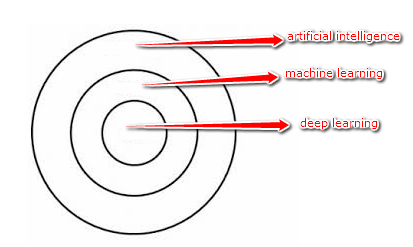Raise your hand if you’ve been caught in the confusion of differentiating artificial intelligence (AI) vs machine learning (ML) vs deep learning (DL)…
Bring down your hand, buddy, we can’t see it!
Although the three terminologies are usually used interchangeably, they do not quite refer to the same things.
Andrey Bulezyuk, who is a German-based computer expert and has more than five years of experience in teaching people how artificial intelligence systems work, says that “practitioners in this field can clearly articulate the differences between the three closely-related terms.”
Therefore, is there a difference between artificial intelligence, machine learning, and deep learning?
Here is an image that attempts to visualize the distinction between them:

As you can see on the above image of three concentric circles, DL is a subset of ML, which is also a subset of AI.
Interesting?
So, AI is the all-encompassing concept that initially erupted, then followed by ML that thrived later, and lastly DL that is promising to escalate the advances of AI to another level.
Let’s dig deeper so that you can understand which is better for your specific use case: artificial intelligence, machine learning, or deep learning.
What is artificial intelligence?
As the name suggests, artificial intelligence can be loosely interpreted to mean incorporating human intelligence to machines.
Artificial intelligence is the broader concept that consists of everything from Good Old-Fashioned AI (GOFAI) all the way to futuristic technologies such as deep learning.
Whenever a machine completes tasks based on a set of stipulated rules that solve problems (algorithms), such an “intelligent” behavior is what is called artificial intelligence.
For example, such machines can move and manipulate objects, recognize whether someone has raised the hands, or solve other problems.
AI-powered machines are usually classified into two groups—general and narrow. The general artificial intelligence AI machines can intelligently solve problems, like the ones mentioned above.
The narrow intelligence AI machines can perform specific tasks very well, sometimes better than humans—though they are limited in scope. The technology used for classifying images on Pinterest is an example of narrow AI.
What is machine learning?
As the name suggests, machine learning can be loosely interpreted to mean empowering computer systems with the ability to “learn”. The intention of ML is to enable machines to learn by themselves using the provided data and make accurate predictions.
ML is a subset of artificial intelligence; in fact, it’s simply a technique for realizing AI. It is a method of training algorithms such that they can learn how to make decisions. Training in machine learning entails giving a lot of data to the algorithm and allowing it to learn more about the processed information.
For example, here is a table that identifies the type of fruit based on its characteristics:
| Weight (grams) | Texture | Type of Fruit |
| 155 | Rough | Orange |
| 180 | Rough | Orange |
| 135 | Smooth | Apple |
| 110 | Smooth | Apple |
| 120 | Smooth | ? |
As you can see on the table above, the fruits are differentiated based on their weight and texture. However, the last row gives only the weight and texture, without the type of fruit.
And, a machine learning algorithm can be developed to try to identify whether the fruit is an orange or an apple.
After the algorithm is fed with the training data, it will learn the differing characteristics between an orange and an apple.
Therefore, if provided with data of weight and texture, it can predict accurately the type of fruit with those characteristics.
What is deep learning?
As earlier mentioned, deep learning is a subset of ML; in fact, it’s simply a technique for realizing machine learning. In other words, DL is the next evolution of machine learning.
DL algorithms are roughly inspired by the information processing patterns found in the human brain. Just like we use our brains to identify patterns and classify various types of information, deep learning algorithms can be taught to accomplish the same tasks for machines.
The brain usually tries to decipher the information it receives. It achieves this through labelling and assigning the items into various categories. Whenever we receive a new information, the brain tries to compare it to a known item before making sense of it—which is the same concept deep learning algorithms employ.
For example, artificial neural networks (ANNs) are a type of algorithms that aim to imitate the way our brains make decisions. We study brains, their waves and patterns, and use the knowledge in developing faster computers – to study brains more efficiently and to train our brains to be smarter, in a closed positive loop.
Comparing deep learning vs machine learning can assist you to understand their subtle differences. For example, while DL can automatically discover the features to be used for classification, ML requires these features to be provided manually.
Furthermore, in contrast to ML, DL needs high-end machines and considerably big amounts of training data to deliver accurate results.
Wrapping up
Do you now understand the difference between AI vs ML vs DL?
Then, raise your hands…
We promise to develop an AI algorithm that tells us whenever someone raises their hand.







